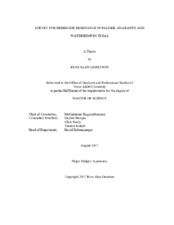| dc.description.abstract | The distribution of herbicide resistance of Palmer amaranth and waterhemp to glyphosate, atrazine, tembotrione, fomesafen, and dicamba are unknown in the State of Texas. A random, semi-stratified survey targeting 6 farming regions where these species would most likely be found was conducted. Seeds from the two species were collected from 15 to 20 individuals to evaluate the sensitivity of these two species to the aforementioned herbicides. A total of 125 Palmer amaranth samples arriving from four regions, High Plains, Central TX, Gulf Coast, and Rio Grande Valley, were screened with the 5 herbicides applied POST at a recommended field rate. For waterhemp, a total of 115 samples originating from the two regions, Upper Gulf Coast and Central TX, were screened with these herbicides. At 21 days after application, a visual rating of survival (yes/no) and injury (0-100%) was taken as compared to a non-treated check and known susceptible/resistant standards. Results showed that resistance to glyphosate is widespread in the High Plains and Upper Gulf Coast, in Palmer amaranth and waterhemp, respectively. An EPSPS gene copy number analysis has revealed that the injury ratings were highly and negatively correlated with gene copy numbers, suggesting that EPSPS gene amplification is an important mechanism that endows resistance in the tested populations. Palmer amaranth resistance to atrazine was the greatest in the Upper High Plains where corn-based cropping systems are predominant. Likewise, atrazine resistant waterhemp was also found widespread in the Upper Gulf Coast region where corn and grain sorghum and widely grown. No resistance was observed for tembotrione, but when ammonium sulfate was not added to the tank-mix (as recommended by the label), it revealed the regional differences in the level of sensitivity to this herbicide. Upper High Plains and the Upper Gulf Coast regions had the greatest number of Palmer amaranth and waterhemp populations, respectively that showed reduced sensitivity to tembotrione. Resistance to fomesafen and dicamba were not detected in the surveyed populations. However, at least one waterhemp population and two Palmer amaranth populations showed reduced sensitivity to reflex and dicamba, respectively. Results revealed that herbicide resistance is an emerging issue in Texas. Best management practices need to be implemented to manage existing resistant populations and also to reduce the risk of resistance evolution to future herbicide options. | en |


